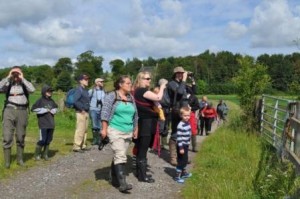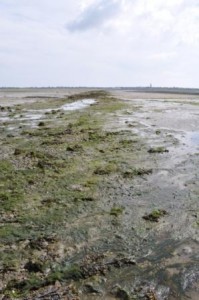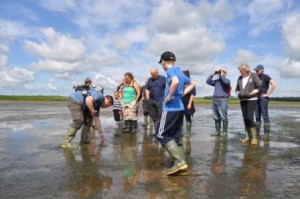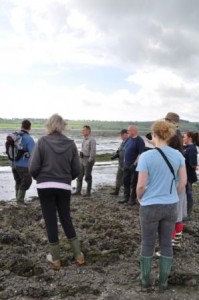Journey to the centre of the mud
The large estuary at Montrose Basin is an extremely dangerous habitat with a mosaic of mud, sand banks, burns, quicksand, mussel beds, shingle banks and the River South Esk running through the middle. It would be unwise for anyone to venture out on the mud without the guidance and expertise of someone who knows where is safe and where to avoid.
In order to allow members of the public to experience the Basin from a completely different perspective in a safe and controlled manner, once a year we run an event called “Journey to the centre of the mud” where we take a group of visitors right out into the middle of the Basin.
We can only run this event when the tides are suitably low and at the right time of day to allow us to safely walk out and back without the risk of being cut off by the incoming tide. This year there was only one date which fell on a weekend and this was last Sunday.
The weather, which is always a concern on these sorts of walks, was miserable on Saturday with heavy rain all day. Thankfully by Sunday morning the weather had cleared up and when we met at Old Mill Car Park just before 10am, the sun was shining and the sky was clear and blue, absolutely glorious.
Heading off from the car park we made our way onto the reserve via the Mains of Dun, and before we had even made it over the old Caledonian railway which marks the boundary of the reserve the group were treated to the sight of two female roe deer feeding on bushes along the field edge.

After a pleasant walk to the sound of yellowhammers and skylarks, we crossed the salt marsh and started to make our way out onto the mud. To minimise the amount of sticky mud we had to cross, we followed the shore line for a short while, where several brown hares foraging through vegetation at the edge of the Basin, before heading out towards the remnants of Dronner’s Dyke which runs from east to west across the estuary and this would be our route to the centre of the Basin.

The dyke, which was constructed between 1677 and the summer of 1678 was designed to drain and reclaim the northern half of the Basin. Thankfully for us, it was never completed and the high tides and storms during the autumn and winter of 1678-79 destroyed it. The dyke was never re-built and many stones from the feature were used in the building of a number of buildings and walls in Montrose town.

Unfortunately for one local lady, the attitude of people at the time meant that they believed the failure of the dyke was down to witchcraft, rather than a natural occurrence and in 1679, Maggie Cowie was tried and found guilty of witchcraft before being executed on top of Maryton Hill overlooking the Basin.
As we walked out over the mud, Richard and I talked about some of the plants and animals which can be found in or on the mud, such as zostra, hydrobia, corophium, lug worms, rag worms, mussels and cockles and explained their importance in attracting such as wide and diverse number of birds to the reserve. We also found some marsh sandfire, which is edible and many celebrity chefs are now using this marine plant in their restaurants.

Eventually we reached the middle of the Basin and took some time to appreciate the enormous size of the Basin and the scale of the reserve and we were even lucky enough to see a large crèche of eider ducklings being led across the mud by several adult females.

After safely making our way back ashore we stopped off at the Shelduck Hide for a bite of lunch and one of the visitors spotted an osprey coming towards us. The whole group got some fabulous views of this stunning bird as it fished on the river before being chased off by a herring gull.
A fantastic day out on the mud and thankfully we got back safely before the torrential rain and thunder and lightning which came in during the afternoon. I don’t know about you, but I wouldn’t fancy being in the middle of the Basin during a lightning storm!
Adam – Montrose Basin Ranger
Help protect Scotland’s wildlife
Our work to save Scotland’s wildlife is made possible thanks to the generosity of our members and supporters.
Join today from just £3 a month to help protect the species you love.
Preface
The large estuary at Montrose Basin is an extremely dangerous habitat with a mosaic of mud, sand banks, burns, quicksand, mussel beds, shingle banks and the River South Esk running …
